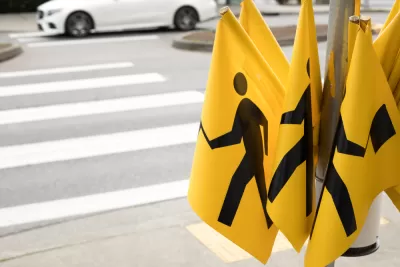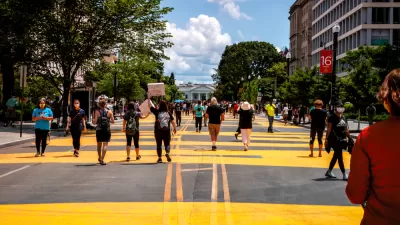Not one, not two, but three articles in the past week paint dire portraits of the world that cars have created.

Allison Arieff pens a column for the New York Times calls out cars as death machines—and self-driving cars won't save us from that reality.
"Cars are death machines. Pedestrian fatalities in the United States have increased 41 percent since 2008; more than 6,000 pedestrians were killed in 2018 alone. More than 4,000 American kids are killed in car crashes every year," write Arieff.
"Here’s the thing: Statistics clearly don’t seem to persuade anyone of the magnitude of this problem. Not policy makers or automakers, technologists or drivers."
As Twitter-using urbanists will recognize, Arieff spent the summer requesting anecdotes of personal experiences with brushes with death, in an attempt to make a different kind of appeal to those with keys to the world designed for these death machines.
Arieff also turns attention to the technologists contingent of aforementioned group, and clearly states an opinion that self-driving cars will not solve the problem of worsening traffic safety.
Among the safety measures proposed by car companies are encouraging pedestrians and bicyclists to use R.F.I.D. tags, which emit signals that cars can detect. This means it’s becoming the pedestrian’s responsibility to avoid getting hit. But if keeping people safe means putting the responsibility on them (or worse, criminalizing walking and biking), we need to think twice about the technology we’re developing.
Arieff follows up that paragraph with one of the great kickers in recent memory. Arieff concludes. However, with an appeal to drive less, which is a goal almost everyone can attain.
Arieff's highly recommended article isn't the only technology-skeptical criticism of cars to be published in recent days. There is also an article by Andrew J. Hawkins about how the ineffectiveness of new safety technology—i.e., cars with all the new safety technology keep running people over. Here is the key evidence cited in that article:
The American Automobile Association (AAA) conducted a series of tests using vehicles with automatic emergency braking and pedestrian detection alerts on a closed course with dummy pedestrians. And what they found was highly upsetting. The vehicles struck the dummy pedestrians that were crossing the road 60 percent of the time — and this was in daylight hours at speeds of 20 mph.
Another article by Peter C. Baker asks why cars are killing more pedestrians. There's heaps of self-driving car skepticism present in this article, like in Arieff's and Hawkins's, but the answer to the question posed in the headline is harder to conjure. Experts aren't totally sure why drivers are killing so many more pedestrians because of the "vast number of variables" involved in each tragic outcome.
Baker's coverage clocks in at long-read status, with plenty of revelatory information to share despite airing on the side of caution in answering the question ultimately behind the entire discourse.
FULL STORY: Cars Are Death Machines. Self-Driving Tech Won’t Change That.

Alabama: Trump Terminates Settlements for Black Communities Harmed By Raw Sewage
Trump deemed the landmark civil rights agreement “illegal DEI and environmental justice policy.”

Study: Maui’s Plan to Convert Vacation Rentals to Long-Term Housing Could Cause Nearly $1 Billion Economic Loss
The plan would reduce visitor accommodation by 25% resulting in 1,900 jobs lost.

Planetizen Federal Action Tracker
A weekly monitor of how Trump’s orders and actions are impacting planners and planning in America.

Waymo Gets Permission to Map SF’s Market Street
If allowed to operate on the traffic-restricted street, Waymo’s autonomous taxis would have a leg up over ride-hailing competitors — and counter the city’s efforts to grow bike and pedestrian on the thoroughfare.

Parklet Symposium Highlights the Success of Shared Spaces
Parklets got a boost during the Covid-19 pandemic, when the concept was translated to outdoor dining programs that offered restaurants a lifeline during the shutdown.

Federal Homelessness Agency Places Entire Staff on Leave
The U.S. Interagency Council on Homelessness is the only federal agency dedicated to preventing and ending homelessness.
Urban Design for Planners 1: Software Tools
This six-course series explores essential urban design concepts using open source software and equips planners with the tools they need to participate fully in the urban design process.
Planning for Universal Design
Learn the tools for implementing Universal Design in planning regulations.
Caltrans
Smith Gee Studio
Institute for Housing and Urban Development Studies (IHS)
City of Grandview
Harvard GSD Executive Education
Toledo-Lucas County Plan Commissions
Salt Lake City
NYU Wagner Graduate School of Public Service





























